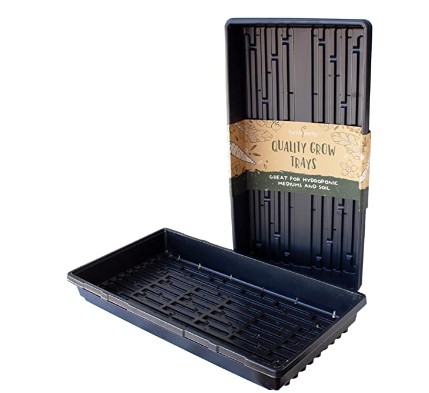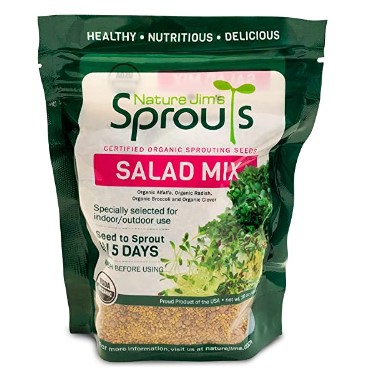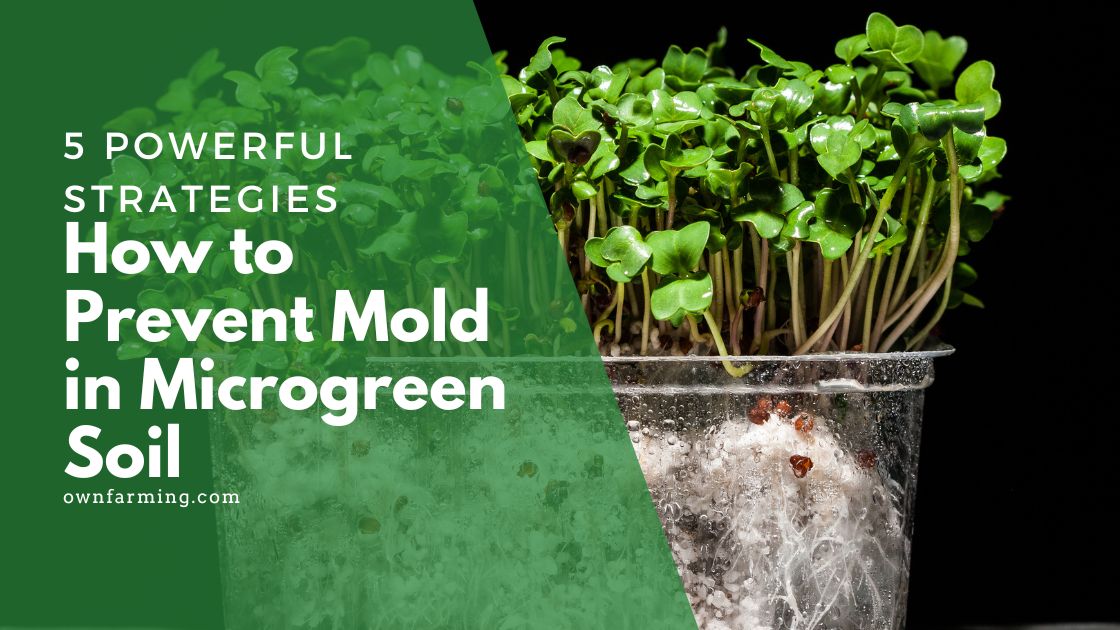Growing microgreens can be an incredibly rewarding experience, but if mold starts to grow in the soil it can quickly ruin your crop. As a result, it is key to learn how to prevent mold in microgreen soil. Mold growth in microgreen soil can be a major problem for gardeners and farmers alike, as it can damage the health of the plants and reduce crop yields.
Fortunately, there are several strategies that you can use to prevent mold from growing in your microgreen soil. In this article, we’ll discuss five powerful strategies for how to prevent mold in microgreen soil so that you can have a successful harvest season.
How to Prevent Mold in Microgreen Soil Quick Guide
By following these tips, you can ensure that your microgreen soil stays free from mold and your plants stay healthy.
However, if you do notice mold growth in your soil, take action quickly to prevent it from spreading. Here are five of the most effective tips on how to prevent mold in microgreens.
- Avoid Overwatering
- Sanitizing the seed
- Preventing overseeding
- Using good quality seeds
- Control the soil
How to Prevent Mold in Microgreen Soil: 5 Strategies
Following these tips and taking proactive measures to prevent mold growth in your soil, you can ensure healthy harvests every season.
Avoid Overwatering
- Excess water can cause mold growth in soil, so make sure that you are not overwatering your microgreens. Monitor the moisture level in the soil and water only when needed.
- To prevent moisture in the soil, opt for trays, planters, or containers with drainage.
- Look for containers with holes at the bottom to let the excess water drain out.
Sanitizing the seed
Seed problems can cause growth production to halt, be ruined by mold, or fail to start at all.
Using hydrogen peroxide to sanitize the seeds can improve the microgreen growing process by removing bacteria from the seeds and avoiding complications.
- To disinfect seeds, first, mix a small amount of food-grade 3% hydrogen peroxide into a bowl of water. You can add 200ml of hydrogen peroxide for every 1 liter of water.
- Then, soak the seeds in the solution for a few hours. Once done, allow the seeds to dry by laying them out on a paper towel.
Prevent Overseeding
- To avoid mold growth in microgreens, make sure to give them enough space. Plant the seeds with some distance between them to allow room for the roots to grow properly.
- Avoid planting the seeds next to each other and spread them out evenly.
- If you are having difficulty determining the correct seeding density, you can use a microgreen seeding density calculator. This tool will assist you in determining the appropriate amount of space to leave based on the size of your container and the type of plant you wish to grow.
Using good quality seeds
- For optimal production and to prevent molding, it’s important to use high-quality microgreen seeds.
- Start by determining which type of microgreens you want to grow.
- Then, conduct research to learn about the characteristics of good quality seeds, where to purchase them, and how to properly grow them.
- To ensure good quality seeds, consider checking reviews from past buyers, seeking advice on forums, researching the seller’s credibility, and asking the seller questions.
Control the soil
- To control moisture when growing microgreens, it’s important to use soil that is designed for this purpose. Consider using a soilless medium like coconut coir, or a nutrient-rich soil that contains nitrogen, phosphorus, and potassium.
- The soil should also be able to retain some water, which means it should include perlite and vermiculite for a sponge-like texture.
- Additionally, adding peat moss or coconut coir can help improve soil airflow.
Recommended Tools That Get The Job Done
5-Pack 1020 Garden Growing Trays with Drain Holes

This 5-pack of 1020 Garden Growing Trays with Drain Holes is perfect for hydroponic growing and seed starting. The trays are made of durable plastic and feature drain holes which make them reusable.
They are also great for greenhouses, seedlings, wheatgrass, microgreens, and more! These Handy Pantry trays are multi-purpose and fit perfectly in 10″ x 20″ drip trays. With these trays, you can propagate seeds, take cuttings, and grow hydroponics or fodder systems easily inside your home or garden.
To prevent mold from forming on soil used in microgreens or other projects simply ensure that the soil has proper aeration to promote healthy drainage so water doesn’t sit stagnant on top of the soil surface.
Nature Jims Sprouts Salad Sprout Mix

Nature Jims Sprouts Salad Sprout Mix is a premium quality topping for any salad, sandwich, or dish. Our mix is made with certified organic and non-GMO seeds so you can rest assured that your meal will be packed with vitamins and minerals.
This unique blend of broccoli, alfalfa, clover, and radish seeds can sprout in just five days! With the Nature Jims Sprouts Salad Sprout Mix, you can enjoy the fresh flavor and texture of homegrown greens without all the fuss.
Plus our careful selection prevents mold from developing in your soil for maximum freshness. Unleash your inner farmer today with Nature Jims Sprouts Salad Sprout Mix.
Essential Oxygen Food Grade Hydrogen Peroxide

Essential Oxygen Food Grade Hydrogen Peroxide is an all-natural, non-GMO cleaner that works to eliminate 1st AID cuts and scrapes, and unwanted microorganisms in the body such as ears, throat, and diffusers.
It’s also effective for household cleaning needs including counters, surfaces, cutting boards, and laundry. Plus it can be used with food items like nuts, seeds, grains, and fruits! It won’t burn like 35% or 6% hydrogen peroxide either.
And best of all – it’s planet positive by helping make the grass greener and oceans cleaner! With this product, you can learn how to prevent mold in microgreen soil or any type of soil so your plants remain healthy.
Common Questions About How to Prevent Mold in Microgreen Soil
Why am I getting mold on my microgreens?
Note that if you bunch up the seeds too closely, there will be a lack of airflow and more moisture will be concentrated in that area due to the growing microgreens.
This creates optimal conditions for mold growth. To avoid this, it’s best to spread out the seeds and leave some space in between each one. This will help your plants grow more effectively.
How do I know if my microgreens have mold?
If you notice white fuzzy growths above the soil line on your mature microgreens, it is probably mold. However, if you see the same white fuzzy growths where the stem meets the soil or growth mat, it could just be root hairs.
What kills mold on microgreens?
To get rid of mold, you can mix a tablespoon of 3% food-grade hydrogen peroxide with 16 ounces of water and then mist it on the affected area. You may need to repeat this process more than once. The mixture is odorless and safe because hydrogen peroxide breaks down into water and oxygen.
Video Microgreen Mold: 4 Ways to Prevent It [Problem Solved]
Mold can be a real problem when it comes to growing microgreens. This video will show you how to prevent mold in your soil so that your microgreen plants grow healthy and strong. You’ll learn the best practices for preventing mold from forming, as well as some tips on how to identify and remove existing mold if needed.
Final Thoughts
Preventing mold in microgreen soil doesn’t have to be a daunting task. By following the simple tips outlined above, you can easily nail how to prevent mold in microgreen soil and keep your soil healthy and free of any unwanted fungi growth. Start by ensuring proper drainage for your soil and using only clean seeds or transplants when planting.
Additionally, make sure that you are regularly checking for signs of mold on the surface of the soil as well as monitoring its temperature and moisture levels throughout the growing season. With these steps in mind, you’ll be able to prevent mold from infiltrating your microgreens and enjoy their fresh flavors all year round!



